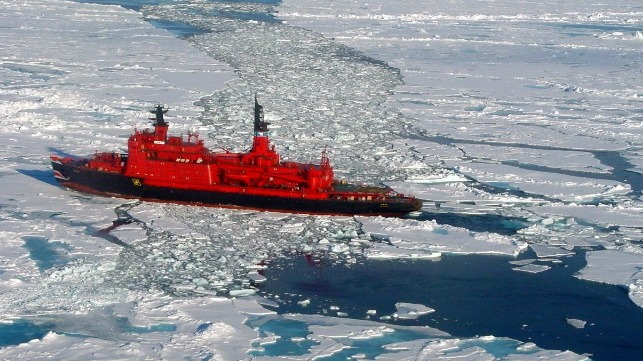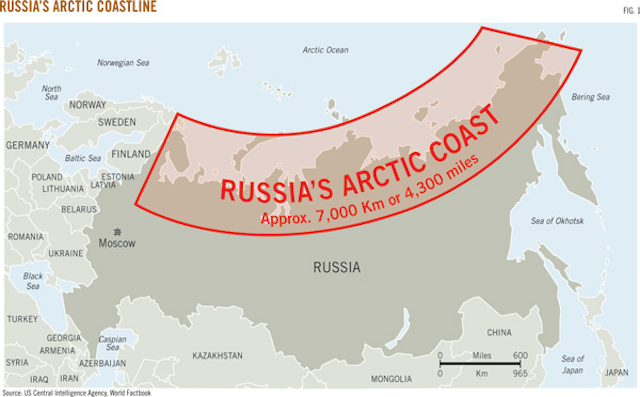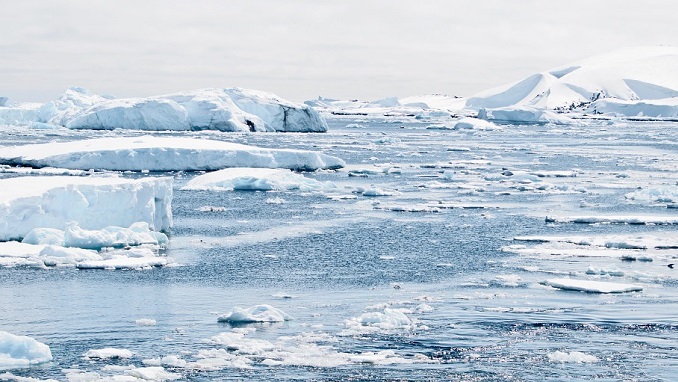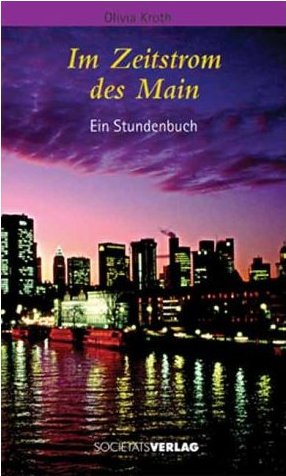Russian military security for the Arctic
by Olivia Kroth

The Arctic is of great importance for Russia. More than one fifth of the Russian territory lies in this zone. Its natural resources are worth about $30 billion. Besides oil and gas, the Arctic shelf contains almost all of Russia’s titanium, tin and barite reserves; 90 percent of Russia’s nickel, kobalt and platinum; 80 percent of Russia’s gold, diamonds, lead, bauxite and apatite; 60 percent of Russia’s copper (Lyudmila Alexandrova, TASS, 15.01.2015). Accordingly, Russia’s Arctic zone needs protection by military means. On Navy Day, the 26th of July 2015, Russia’s new military doctrine was unveiled. The main purpose of this complex document is «to provide a coherent, consistent and effective maritime policy for Russia, aimed at protecting its national interests» (RUSSIA & INDIA REPORT, 31.07.2015). Furthermore, this summer the Russian Federation submitted to the UN a bid to extend its Arctic shelf by 1.2 million square kilometres.

The new maritime doctrine stresses the importance of the Arctic for Russia, due to the Northern Sea Route, free access to the Atlantic and Pacific, and of course the very rich continental shelf. The Russian Arctic consists of the Murmansk Region and some parts of the Arkhangelsk Region; the Nenets, Chukot and Yamal-Nenets autonomous districts; the urban district of Vorkuta in the Komi Republic as well as the urban district of Norilsk in the Krasnojarsk Region. Norilsk is counted as the northernmost city of the world. A large number of island groups and sole islands belong to the Russian Arctic. They lie scattered around the marginal seas of the Arctic Ocean: Barents Sea, Kara Sea, Laptev Sea, East Siberian Sea, Chukchi Sea and Bering Sea.
«While all Arctic countries have a combined population of about four million, two million of them are Russian citizens. Of the 12 Arctic cities eleven are Russian» (Lyudmila Alexandrova, TASS, 05.08.2015). Soon, the Russian Arctic region might be further extended by 1.2 billion square kilometres, if the UN Commission on the Limits of the Continental Shelf decides in favour of Russia’s recent bid. To back up its request the Russian Federation conducted extensive research on the underwater seabed of the Arctic. The Russians want to prove that the eastern part of the underwater Lomonosov Ridge and also the Mendeleyev Ridge are extensions of the Russian mainland, belonging to Russia. The bid will be considered in spring 2016.
Rosneft drilling station in the Russian Kara Sea:
At the beginning of December 2014, the formation of a new Joint Strategic Command for the Arctic was decreed, as NEZAWISIMAJA GAZETA reported. It is formed on the basis of the Russian Northern Fleet and has been named as a fifth Russian military district, besides the Western, Central, Southern and Eastern military districts. The Arctic Joint Strategic Command is aimed at protecting Russian interests in the Arctic region, with the Northern Fleet as its main striking force. The Russian Ministry of Defence plans to install 13 airfields and ten radar units in the Arctic. A new airfield is being built on Alexandraland, an island of the archipelago Franz Josef Land. The runway will be 2.500 metres long. Pilots will only land there during good weather, using airfield runway beacons. Seven former Soviet Arctic airfields are being modernized and opened again: Tiksi, Naryan-Mar, Alykel, Amderma, Anadyr, Rogachyovo and Nagurskoye. Arctic troops are going to be stationed on Kotelny Island, Wrangel Island, Alexandraland, the archipelago Novaya Zemlya and Cape Schmidt.
To prepare the stationing of troops, appropriate buildings need to be erected in the Arctic. In summer 2014, Russia began to build houses on Wrangel Island and at Cape Schmidt. Each military settlement consists of homes, an administrative unit and a sports complex with sauna and relax area. The structures are connected with each other in the form of a star, so that people can move within the buildings without being exposed to the extreme cold outside (VOICE OF RUSSIA, 08.09.2014). In June 2015, servicemen of the Russian Defense Ministry began an ecological clean-up of the Arctic, where military formations are to be stationed. 170 soldiers are involved in the clean-up of Kotelny Island, Wrangel Island and Novaya Zemlya. They are «dismantling shabby houses, old constructions and removing scrap metal, including metallic containers for liquid substances, pending their shipment away from the Arctic territory by auxiliary ships of the Russian Navy» (TASS, 22.06.2015).


On a large number of Arctic islands, the Russians are constructing infrastructure facilities. Providing comfortable conditions for military personnel features highly on the lists of tasks. On Kotelny Island, the largest in the Novosibirsk Islands archipelago, a closed-cycle administrative and residential compound called Severny Klever (Northern Clover) is under construction. Another similar compound is being built on Alexandraland. Infrastructure is also created on Rogachyovo Island in the Novaya Zemlya archipelago and on one of the Severnaya Zemlya islands. All of these infrastructural complexes are conceived as part of a comprehensive system for enhancing security in the Arctic Region (TASS, 01.06.2015).
Not only human beings but machines are also sensitive to extreme cold. Soldiers need to be protected, special engines must be developed for the the Arctic. New uniforms have been designed to keep the troops warm, even in extreme temperatures down to minus 57 degrees Celsius. The military-medical academy has created norms for Arctic diet. The Russian Defence Ministry issued a list with snow and swamp-going vehicles, military tracked vehicles and military snowmobiles for the Arctic. As IZVESTIJA reported, these new vehicles were tested in the region of Murmansk. Fifteen types of tracked and wheeled vehicles for Artic troops will enter duty by the end of 2015. With these vehicles, Arctic troops will be able to cross swamps and drive safely over ice and snow. Furthermore, new types of fuels and lubricants capable of ensuring their reliable operation in extremely low temperatures have been developed (TASS, 04.06.2015).

The United Instrument Making Corporation, a subsidiary of Rostec, is developing a tracked modular robotized vehicle for combat, fire extinguishing and Arctic expeditions. It can carry two tons of payload and move at a speed of 40 kilometres per hour. This robotized vehicle is designed for areas that are hazardous for humans. It can operate in a semi-automated mode within a 10 kilometres radius from the control centre. The United Instrument Making Corporation is planning to install a technical vision system allowing to identify objects and to navigate without the operator’s help. The vehicle will also get fully automated control with elements of artificial intellect (TASS, 12.05.2015).
http://rostec.ru/en/news/4516482
Russia’s newest Mil Mi-26 T2 heavy helicopter has also been adapted to Arctic conditions. It is an update of the Mi 26 T with new avionics, which helps reduce the crew to two or three men. It is equipped with the BREO-26 airborne electronic system, allowing it to fly any time, day or night, under good and bad weather conditions. Serial production began in May 2015 (TASS, 20.08.2015). The Russian Defence Ministry has stationed modern weapons like the Pantsyr short-range air defence system on its islands in the Arctic Ocean. New radar systems are being installed and fighter aircraft are on the way (TASS, 20.06.2015).
Increased Russian military presence in Arctic:

MiG-31 fighters are getting a new version of the onboard electronic warfare complex Vitebsk. Furthermore, a new navigation system for operations in the Arctic has been developed. The MiG-31 fighters will get a strap down inertial navigation system. It will enable the fighters to navigate in the Arctic without correction from GPS and GLONASS satellites. The system can operate at very low temperatures. It will ensure fully autonomous high precision navigation in situations where the use of other navigation systems is impossible. The navigation system comes Concern Radio-Electronic Technologies (KRET), a subsidiary of Rostec. KRET consists of 95 enterprises, engaged in the development and production of military and civilian radio-electronics. KRET enterprises are located all over the Russian Federation, from Saint Petersburg to Vladivostok. (TASS, 23.06.2015).
Meanwhile Russia’s Federal Space Agency is developing a GLONASS Arctic navigation segment to improve the system’s accuracy in the Arctic. This project envisages adding four to six satellites in geosynchronous inclined orbits to the GLONASS system. These orbits have their inclination between the polar and equatorial (geostationary) orbits with an inclination angle of 63 degrees. Together with GLONASS signals, this new segment will help to locate objects in the Arctic with an accuracy of 0.6 metres, according to a document issued by Roscosmos (TASS, 31.07.2015).
The Chukhchi Peninsula in 1921:

 On the 1st of May 2015, a group of Russian Orlan-10 drones, deployed in the Chukhchi Peninsula, started monitoring the islands. Their task is to maintain control of the situation, including the ecological and ice situation in the adjoining sea areas. Graduates of the Defence Ministry’s remote control aviation centre are replenishing the personnel of the drones unit in the Chukchi Peninsula (TASS, 23.04.015). Since June 2015, Tachyron and Aileron-3 drones are also patrolling the Arctic. They were designed for reconnaissance missions and are capable of flying at distances from ten to 150 kilometres, depending on their modification. These drones transmit videos to the operator, day and night. The Tachyron drones went into service after tests by motorized infantry troops of the coastal defence forces of the Northern Fleet on Franz Josef Land, in May 2015 (TASS, 17.06.2015).
On the 1st of May 2015, a group of Russian Orlan-10 drones, deployed in the Chukhchi Peninsula, started monitoring the islands. Their task is to maintain control of the situation, including the ecological and ice situation in the adjoining sea areas. Graduates of the Defence Ministry’s remote control aviation centre are replenishing the personnel of the drones unit in the Chukchi Peninsula (TASS, 23.04.015). Since June 2015, Tachyron and Aileron-3 drones are also patrolling the Arctic. They were designed for reconnaissance missions and are capable of flying at distances from ten to 150 kilometres, depending on their modification. These drones transmit videos to the operator, day and night. The Tachyron drones went into service after tests by motorized infantry troops of the coastal defence forces of the Northern Fleet on Franz Josef Land, in May 2015 (TASS, 17.06.2015).
In August 2015, Russia’s Northern Fleet held an Arctic drill aimed at assessing the troops’ readiness on unfamiliar terrain. The tactical exercise took place on the Taymyr Peninsula near Norilsk (TASS, 24.08.2015). The first stage of the drills unfolded in Dudinka, the strategically important port operated by mining company Norilsk Nickel. The Northern Fleet vessels “Georgiy Pobedonosets” and “Kondopoga”, as several more ships, were involved. The rehearsal also included combat training in the area of the Norilsk airport, the village of Alykel and the plant territory of the Norilsk Nickel melters. Paratroopers, navy infantry, aircraft and helicopters participated in the drill (BARENTS OBSERVER, 20.08.2015).

The Northern Fleet was established as part of the Soviet Navy, in 1937. Its current commander is Vladimir Korolev. The fleet is based in Severomorsk, its nuclear-powered Arktika ice-breakers are stationed in Murmansk. This city is developing into a major Northern industrial park which needs military protection. Rosneft is developing offshore Arctic oil in Murmansk. The main tasks of the Rosneft industrial park are transfer of equipment and technologies for offshore oil and gas development in the Arctic, training specialists in the Centre of Arctic Competences and in the Arctic Research Centre for Offshore Projects. The coastal logistics base will be expanded until 2025, with overall costs of 18 billion rubles. The area of Rosneft’s coastal base in Murmansk comprises 140 hectares. This project wields tangible social benefits, creating up to 2.000 new jobs over a period of five years. Most employees of the Rosneft industrial park are local residents of Murmansk (TASS, 18.06.2015).
The Arktika and Taymyr icebreakers will eventually be replaced by newer models, as the internet site of Rosatomflot informs. «The atomic icebreaking fleet is the key element of Russian geopolitical interests protecting the Arctic. Full-scale and regular commercial shipping along the Northern Sea Route was organized in 1920. Since that time, the basic stages of the navigational routes have been determined by the increase in icebreaking fleet power, especially with the world’s most powerful icebreakers, Arktika and Taymyr. Since 1976, atomic icebreakers have been piloting vessels with cargoes to the Yamal Peninsula in winter time. Rosatomflot is ready to pilot bulk carriers, gas carriers and tankers on a year-round basis. To successfully operate in the Arctic Russia is constantly developing and improving its atomic icebreaking fleet. A new generation of atomic icebreakers is being designed (LK-60 N). This icebreaker will have the overall power of 60 MW with variable draught, from 8,5 m to 10,8 m.»
http://rosatomflot.ru/index.php?menuid=20&lang=en

Russia’s Northern Sea Route comprises all navigable shipping lanes from the Kara Sea to the Pacific Ocean, specifically running along the Russian Arctic coast, from the Kara Gates strait between the Barents Sea and the Kara Sea, along Siberia, to the Bering Strait. The entire route lies in Arctic waters and within Russia’s Exclusive Economic Zone (EEZ), which stretches 200 miles northwards from Russia’s northern archipelagoes and islands: Franz Josef Land, Severnaya Zemlya, the Novosibirsk Islands and Wrangel Island. The Northern Sea Route as a national transport corridor plays a major role in Russia’s further economic development of its northern regions and the state in general.
The flow of cargo began to increase, in 2000. From 2005 to 2007, the amount of cargo shipped on Russia’s Northern Sea Route exceeded two million tons, and it keeps growing. President Vladimir Putin said that the Northern Sea Route had «a golden future as an international trade route» (SPIEGEL ONLINE, 22.08.2015). Russia’s tourism agency also promotes the Northern Sea Route, suggesting Arctic cruises. The potential market could amount to 80.000 tourists a year. In 2015, the first three Arctic cruises to Franz Josef Land were launched. More cruises are planned to follow the Northern Sea Route, which is a very important element of strengthening Russia’s standing in the Arctic (TASS, 17.08.2015).
Russia’s nuclear icebreaker Arktika:

Olivia Kroth: The journalist and author of four books lives in Moscow.
Her blog:
https://olivia2010kroth.wordpress.com
















_REFON.jpg/270px-Ip%C3%AA_(Avar%C3%A9)_REFON.jpg)

